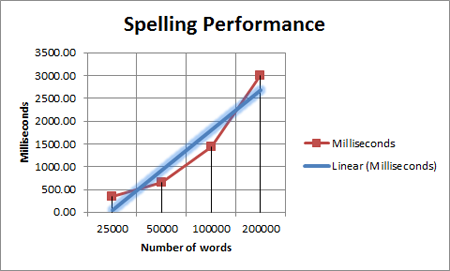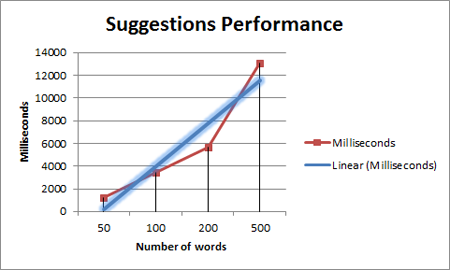TX Spell: Performance Considerations
TX Spell .NET has been built from ground up to match the key principles of performance, reliability and accuracy. Based on our experience in word processing applications, we were able to develop a spell checking component that is tailored to the special requirements of such applications. Especially when working with large files with hundreds of pages, the spell checking engine must be fast -- really fast. When enabling the spell-as-you-type functionality, the whole text must be checked. To…

TX Spell .NET has been built from ground up to match the key principles of performance, reliability and accuracy. Based on our experience in word processing applications, we were able to develop a spell checking component that is tailored to the special requirements of such applications.
Especially when working with large files with hundreds of pages, the spell checking engine must be fast -- really fast. When enabling the spell-as-you-type functionality, the whole text must be checked. To avoid long waiting times when users load large documents or when longer text is pasted into an existing document, a fast and at the same time accurate spell checking engine should be used.
When loading a long document, the initial check must be finished quickly. On checking the whole text, every word is checked based on the used dictionaries. Misspelled words are added to the IncorrectWordCollection and, when used in combination with TX Text Control, underlined with a red wiggly line.
The following diagram shows the linear performance on checking 25.000, 50.000, 100.000 and 200.000 words based on the standard US English dictionary:

The above diagram shows that TX Spell .NET is able to check about
75.000 words in about a second.
In a word processing application, the end user uses a context menu or a spell checking dialog to correct misspelled words. In such a menu or dialog, TX Spell .NET shows suggestions for a misspelled word. In real-life, this performance indicator is not that important as a single word is processed at a time. Nevertheless, performance is important in this step as well.
Based on the US English dictionary and a 5 characters long word, TX Spell .NET takes less than 0.035 seconds on average per word to create the appropriate suggestions. Based on these numbers, the suggestions can be calculated on-the-fly when opening a context menu. Of course, all numbers depend on the used dictionaries and the words themselves. But these numbers show that the reached performance is nearly unrivaled.

You haven't tested TX Spell .NET yet? Download a free trial version now!
Related Posts
Spell CheckingTechnical Article
Deploying TX Spell .NET in an XBAP Browser Application
XBAP is a very smart way to deploy full .NET Framework WPF applications in the browser. With .NET 3.5 and 4.0, that means MS Internet Explorer and Firefox. Of course, TX Spell .NET for WPF and the…
Service Pack 1 for TX Spell .NET 7.0 Released
We are very happy to announce the immediate availability of new Service Packs for all TX Spell .NET 7.0 products.
Proofing Tools Available As ReportingCloud Web API Endpoints
We just rolled out 3 new ReportingCloud endpoints to integrate spell checking functionality to your cloud-based applications in more than fifty languages.
HyphenationServerTextControlSpell Checking
Using TX Spell .NET with ServerTextControl
TX Spell .NET comes with a core assembly and separate assemblies for the Win32 platforms Windows Forms and WPF. When using TX Spell .NET with the non-UI version of TX Text Control…
HTML5: Enable Spell Checking Using Javascript
IMPORTANT: This feature is now part of the JavaScript API: Javascript: TXTextControl.isSpellCheckingEnabled property ? TX Text Control .NET Server ? JavaScript API ? TXTextControl Object ?…

